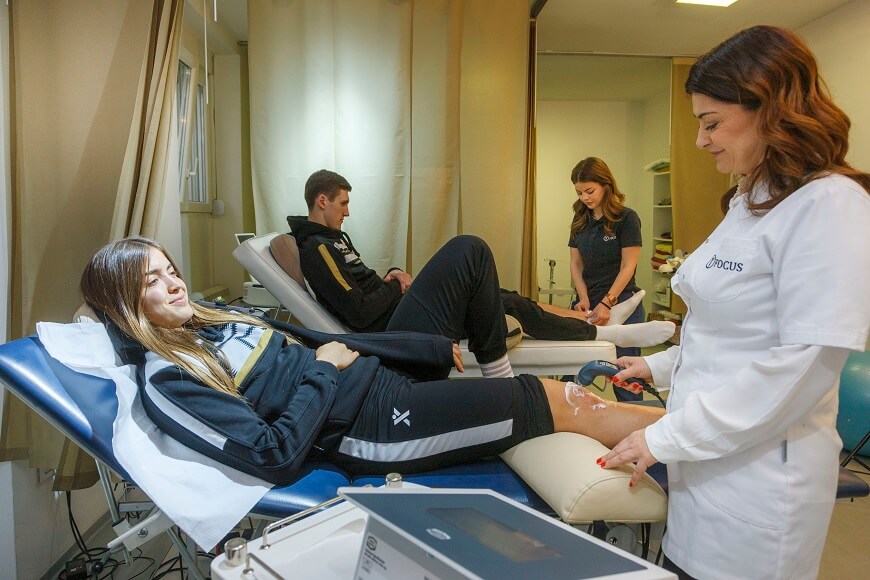
Physical therapy
What is physical therapy? The concept of physical therapy. What injuries, conditions and diseases does physical therapy treat? Types of physical therapy
What is physical therapy?
What is physical therapy? Belgrade, Serbia. TOP PRICE✓ Physiotherapist✓ How long does physical therapy take✓ Physiatrist✓ Physical medicine and rehabilitation✓
Physical therapy is a professional medical treatment that helps people recover from injuries, surgeries, or manage the symptoms of health conditions that affect their mobility. It uses a combination of different methods, such as exercises, stretches and movements, which increase strength, flexibility and mobility, thereby allowing easier movement and reducing pain. The goal of physical therapy is to help you move safely and effectively, whether you're recovering from an injury or trying to overcome certain physical disabilities.
Definition of physical therapy
Physical therapy is a medical treatment that focuses on restoring the body's physical functions as well as improving mobility. It is often part of a rehabilitation plan after surgery or injury, but it can also be preventive, to avoid future injuries or reduce the risk of diseases that can affect mobility. In many cases, physical therapy is key to achieving a full recovery and returning to daily activities.
The therapy is always led by a physiotherapist - an expert who uses different methods to guide you through the therapeutic processes, while ensuring your safety during each treatment.
How long physical therapy lasts depends on the type of injury or condition, as well as which area of the body needs to be rehabilitated. Some people complete therapy in a few weeks, while others need therapy for months and sometimes years, especially if they have chronic problems.
Koje povrede i stanja leči fizikalna terapija?
Physical therapy is used to rehabilitate many types of injuries and conditions. Some of the most common reasons people choose physical therapy include:
- Sports injuries
- Pain in the back
- Knee injuries
- Hip injuries
- Carpal tunnel syndrome
- Tendonitis (inflammation of the tendons)
- Rotator cuff injuries
- Knee ligament injuries (eg ACL tears)
- Temporomandibular joint (TMJ) problems
- Concussions
- Stroke
- Spinal injuries
- Head trauma
In addition, physical therapy can be beneficial for people with chronic conditions such as:
- Chronic Obstructive Pulmonary Disease (COPD)
- Cerebral palsy
- Multiple sclerosis
- Muscular dystrophy
- Parkinson's disease
- Cystic fibrosis
How long does physical therapy last?
Physical therapy lasts from several weeks to several months, depending on the type of injury and recovery goals. Acute injuries, such as sprains or minor muscle injuries, usually require 2-6 weeks of therapy. In cases of chronic conditions, such as back pain or arthritis, the therapy may last longer than several months, with a gradual reduction in intensity. The therapist adjusts the treatment plan according to the patient's progress, in order to achieve optimal results. Regular monitoring of progress enables timely adjustments in therapy.
Each individual physical therapy session usually lasts between 30 and 60 minutes, depending on the type of exercise and recovery. In the initial stages, therapy is often carried out 2-3 times a week, in order to achieve faster progress. As the patient progresses, the number of sessions can be reduced to 1-2 times a week. The therapist may also recommend exercises that the patient should perform at home to speed up recovery. All recommendations and frequency of sessions depend on the specific condition of the patient and progress during treatment.
Types of physical therapy
Physical therapy includes a wide range of treatments that include different techniques and methods. The most commonly used therapies at Fokus Physical Therapy Belgrade include:
Benefits and risks of physical therapy
Benefits of physical therapy:
Physical therapy helps restore and improve the function of all body systems that affect mobility, including:
- Musculoskeletal system: Strengthening of muscles, bones and joints.
- Nervous System: Improving nerve function and communication between the brain and body.
- Cardiovascular and respiratory system: Improvement of heart and lung function.
- Skin: Help to restore the sensitivity and stability of the skin after injuries.
Physical therapy can help you relieve pain, improve your body's mobility and functionality, allowing you to return to your daily activities.
Risks of physical therapy:
Although physical therapy is very safe and effective, like any physical activity, there is a small risk of injury, especially if the therapy is not performed correctly or if it is too intense. Always consult a physical therapist to ensure that therapy is performed correctly and safely.
Is physical therapy worth the effort?
Although it can be challenging and demanding, physical therapy definitely has long-term benefits. You may feel exhausted or stressed at first, but with consistency and patience, your strength, flexibility and mobility will improve over time.
When should you see a doctor?
If you notice worsening symptoms or new problems, contact your doctor. Also, let your physical therapist know if any parts of the therapy become too difficult or too easy, so they can adjust the treatment plan to your progress.
Physical therapy vs. occupational therapy
Although both forms of therapy are aimed at improving physical functionality, there is a clear difference in their goals. Physical therapy is used to rehabilitate injuries and reduce pain, while occupational therapy helps people improve their ability to perform daily activities, such as dressing, shopping or using a computer. Occupational therapy is more focused on improving independence in life, while physical therapy is more focused on physical healing and restoration of mobility.
Through customized exercises, stretching and massage techniques, physical therapy helps you return to your daily activities, pain-free and with greater flexibility. Whether you're recovering from an injury or looking to prevent new ones, a physical therapist can help you improve your physical health and body functionality.